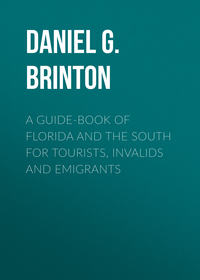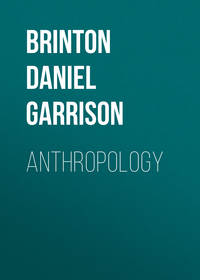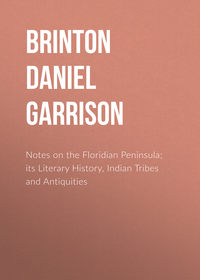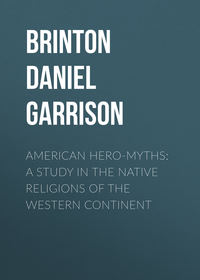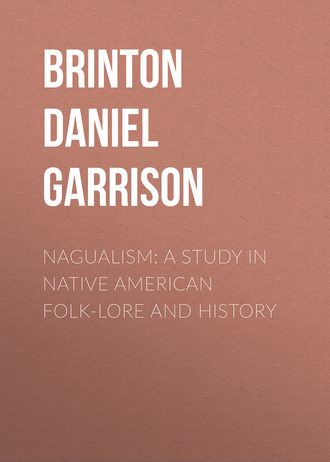 полная версия
полная версияNagualism: A Study in Native American Folk-lore and History
The German traveler, Dr. Scherzer, when he visited, in 1854, the remote hamlet of Istlavacan, in Guatemala, peopled by Quiché Indians, discovered that they had preserved in this respect the usages of their ancestors almost wholly unaffected by the teachings of their various Christian curates. The “Master” still assigned the naguals to the new-born infants, copal was burned to their ancient gods in remote caves, and formulas of invocation were taught by the veteran nagualists to their neophytes.48
These Zahoris,49 as they are generally called in the Spanish of Central America, possessed many other mysterious arts besides that of such metamorphoses and of forecasting the future. They could make themselves invisible, and walk unseen among their enemies; they could in a moment transport themselves to distant places, and, as quickly returning, report what they had witnessed; they could create before the eyes of the spectator a river, a tree, a house, or an animal, where none such existed; they could cut open their own stomach, or lop a limb from another person, and immediately heal the wound or restore the severed member to its place; they could pierce themselves with knives and not bleed, or handle venomous serpents and not be bitten; they could cause mysterious sounds in the air, and fascinate animals and persons by their steady gaze; they could call visible and invisible spirits, and the spirits would come.
Among the native population of the State of Vera Cruz and elsewhere in southern Mexico these mysterious personages go by the name padrinos, godfathers, and are looked upon with a mixture of fear and respect. They are believed by the Indians to be able to cause sickness and domestic calamities, and are pronounced by intelligent whites to present “a combination of rascality, duplicity and trickery.”50
17. The details of the ceremonies and doctrines of Nagualism have never been fully revealed; but from isolated occurrences and partial confessions it is clear that its adherents formed a coherent association extending over most of southern Mexico and Guatemala, which everywhere was inspired by two ruling sentiments – detestation of the Spaniards and hatred of the Christian religion.
In their eyes the latter was but a cloak for the exactions, massacres and oppressions exerted by the former. To them the sacraments of the Church were the outward signs of their own subjugation and misery. They revolted against these rites in open hatred, or received them with secret repugnance and contempt. In the Mexican figurative manuscripts composed after the conquest the rite of baptism is constantly depicted as the symbol of religious persecution. Says a sympathetic student of this subject:
“The act of baptism is always inserted in their records of battles and massacres. Everywhere it conveys the same idea, – making evident to the reader that the pretext for all the military expeditions of the Spaniards was the enforced conversion to Christianity of the natives; a pretext on which the Spaniards seized in order to possess themselves of the land and its treasure, to rob the Indians of their wives and daughters, to enslave them, and to spill their blood without remorse or remission. One of these documents, dated in 1526, adds a trait of savage irony. A Spanish soldier is represented dragging a fugitive Indian from a lake by a lasso around his neck; while on the shore stands a monk ready to baptize the recreant on his arrival!”51
No wonder that the priests of the dark ritual of Nagualism for centuries after the conquest sought to annul the effects of the hated Christian sacraments by counteracting ceremonies of their own, as we are told they did by the historian Torquemada, writing from his own point of view in these words:
“The Father of Lies had his ministers who aided him, magicians and sorcerers, who went about from town to town, persuading the simple people to that which the Enemy of Light desired. Those who believed their deceits, and had been baptized, were washed on the head and breast by these sorcerers, who assured them that this would remove the effects of the chrism and the holy oils. I myself knew an instance where a person of prominence, who resided not far from the City of Mexico, was dying, and had received extreme unction; and when the priest had departed one of these diabolical ceremonialists entered, and washed all the parts which had been anointed by the holy oil with the intention to destroy its power.”52
Similar instances are recorded by Jacinto de la Serna. He adds that not only did the Masters prescribe sacrifices to the Fire in order to annul the effects of extreme unction, but they delighted to caricature the Eucharist, dividing among their congregation a narcotic yellow mushroom for the bread, and the inebriating pulque for the wine. Sometimes they adroitly concealed in the pyx, alongside the holy wafer, some little idol of their own, so that they really followed their own superstitions while seemingly adoring the Host. They assigned a purely pagan sense to the sacred formula, “Father, Son and Holy Ghost,” understanding it to be “Fire, Earth and Air,” or the like.53
Whoever or whatever was an enemy to that religion so brutally forced upon these miserable creatures was to them an ally and a friend. Nuñez de la Vega tells us that he found written formulas among them reading: “O Brother Antichrist, Brother Antichrist, Brother Antichrist, come to our aid!” – pathetic and desperate appeal of a wretched race, ground to earth under the iron heels of a religious and military despotism.54
18. The association embraced various tribes and its members were classified under different degrees. The initiation into these was by solemn and often painful ceremonies. Local sodalities or brotherhoods were organized after the manner of those usual in the Roman Church; but instead of being named after St. John or the Virgin Mary they were dedicated to Judas Iscariot or Pontius Pilate out of derision and hatred of the teachings of the priests; or to the Devil or Antichrist, who were looked upon as powerful divinities in opposition to the Church.55
There were certain recognized centres of the association, near which its most important dignitaries resided, and where their secret councils and most imposing ceremonies were held. One of these was Zamayac, in the province of Suchiltepec; a second near Huehuetan, Soconusco; a third at Totonicapan, Guatemala; a fourth at Cancuc, Chiapas; a fifth at Teozapotlan, Oaxaca; and a few others may be surmised.
The high priest who resided at each of these centres exercised control over all the nagualistic teachers and practitioners in an extensive district. On the occasion of an official inquiry by the Spanish authorities it was ascertained that the high priest of Zamayac included under his rule nearly one thousand sub-priests,56 and no doubt others of his rank were not less potent.
The unity between the members of the association over an indefinitely wide area was perfectly well known to the Spanish priests and civil authorities. The ceremonies, formulas and methods of procedure were everywhere identical or alike. This itself was justly regarded as a proof of the secret intelligence which existed among the members of this cabalistic guild.57
To a certain extent, and at least in some localities, as Chiapas and Guatemala, the priesthood of Nagualism was hereditary in particular families. This is especially stated by the historian Ordoñez y Aguiar, who had exceptional opportunities for acquainting himself with the facts.58
A traveler of the first decade of this century, who has left us a number of curious details of the superstitions of the Christianized Indians in Mexico of that day, Benito Maria de Moxò, informs us that he had discovered the existence of different grades in the native soothsayers and medicine men, and that all in a given locality recognized the supremacy of one whom they referred to as “the little old man,” El Viejito. But he was unable to ascertain by what superior traits or rights he obtained this distinction.59
According to some authorities, the highest grade of these native hierophants bore among the Nahuas the symbolic name of “flower weavers,” Xochimilca, probably from the skill they had to deceive the senses by strange and pleasant visions.60 In the south they were spoken of as “guardians,” which may have been derived from the classes of priests so-called in the Zapotec religion.61
19. It will be seen from the above, that Nagualism, beginning in an ancient superstition dating back to the time of primitive barbarism, became after the Conquest a potent factor in the political and social development of the peoples among whom it existed; that it was the source from which was drawn and the means by which was sustained the race-hatred of the native American towards his foreign conquerors, smouldering for centuries, now and then breaking out in furious revolt and civil war.
There is strong reason to suspect its power where, for obvious reasons, it has not been demonstrated. It has always been a mystery and a matter of surprise to the historians of Yucatan how rapidly spread the plans of the insurrection which secured lasting independence for the natives, after these plans had been agreed upon by the two chiefs, Antonio Ay and Cecilio Chi, at the remote rancho of Xihum, in July, 1847. Such unanimity of action could only have been possible through the aid of a powerful, well-disciplined and widespread secret organization. There can scarcely be a doubt they were the chiefs or masters of the redoubtable order of Nagualism in the Peninsula.62
There is no question that such was the case with the brief and bloody revolt of the Mayas in 1761. It suddenly broke out in a number of villages near Valladolid, Yucatan, headed by a full-blood native, Jacinto Can-Ek; but some of the participants afterwards confessed that it was the outcome of a conspiracy which had been preparing for a year.
When the appointed day arrived, Jacinto boldly announced himself as the high priest of the fraternity of sorcerers, a master and teacher of magic, and the lineal successor of the famous ancient prophet, Chilan Balam, “whose words cannot fail.” In a stirring appeal he urged his fellow-countrymen to attack the Spaniards without fear of consequences.
“‘Be not afraid,’ he exclaimed, ‘of their cannons and their forts; for among the many to whom I have taught the arts of magic (el arte de brujeria) there are fifteen chosen ones, marvelous experts, who by their mystic power will enter the fortress, slay the sentinels, and throw open the gates to our warriors. I shall take the leaves of the sacred tree, and folding them into trumpets, I shall call to the four winds of heaven, and a multitude of fighting men will hasten to our aid.’”63
Saying this, he took a sheet of paper, held it up to show that it was blank, folded it for a moment, and then spread it out covered with writing! This deft trick convinced his simple-minded hearers of the truth of his claims and they rushed to arms. He led them, clothed in the robe of the Virgin and with her crown on his head. But neither their enthusiasm nor their leader’s art magic availed, and soon Jacinto and his followers fell victims to the stake and the gallows. After their death the dance of “the tiger,” or of Chac-Mool – the “ghost dance” of the Mayas – was prohibited; and the use of the sacred drum – the favorite instrument of the native priests – was forbidden.64
In fact, wherever we have any full accounts of the revolts against the Spanish domination during the three centuries of its existence in New Spain, we can manifestly trace the guiding fingers of the powerful though hidden hand of Nagualism. An earlier revolt of the Mayas in Yucatan occurred in 1585. It was led by Andres Chi, a full-blood Indian, and a descendant of the ancient royal house of the Cocomes. He also announced himself as a priest of the ancient faith, a prophet and a worker of miracles, sent to instruct his own people in a new religion and to give them an independent political existence. Seized by the Spaniards, he was charged with idolatry, sorcery and disturbing the peace, and was ignominiously hanged.65
Not less definitely inspired by the same ideas was the Mixe Indian, known as “Don Pascual,” who led the revolt of the Tehuantepec tribes in 1661. He sent out his summons to the “thirteen governors of the Zapotecs and Chontales” to come to his aid, and the insurrection threatened to assume formidable proportions, prevented only by bringing to bear upon the natives the whole power of the Roman Church through the Bishop of Oaxaca, Cuevas Davalos.66
Nearly the same locality had been the scene of the revolt of the Zapotecs in 1550, when they were led by a native priest who claimed to be an incarnation of the old god Quetzalcoatl, the patron deity of the nagualists.67
In the city of Mexico itself, in the year 1692, there was a violent outbreak of the natives, when they destroyed three million dollars worth of property. Doubtless this was partly attributable to the scarcity of food which prevailed; but that the authorities traced it also to some secret ceremonials is evident from the law which was immediately passed forbidding the Indians to wear the piochtli, or scalp-lock, a portion of the hair preserved from birth as part of the genethliac rituals,68 and the especial enactments against the octli.
As for the revolt of the Tzentals of Chiapas, in 1712, it was clearly and confessedly under the leadership of the nagualistic priesthood, as I shall indicate on a later page.
The history of the native American race under the Spanish power in North America has never yet been written with the slightest approach to thoroughness. He who properly qualifies himself for that task will certainly reach the conclusion expressed a number of years ago by the eminent American antiquary and historian, Mr. E. G. Squier, in these words:
“Among the ruling and priestly classes of the semi-civilized nations of America, there has always existed a mysterious bond, a secret organization, which all the disasters to which they have been subjected have not destroyed. It is to its present existence that we may attribute those simultaneous movements of the aborigines of Mexico and Central America, which have more than once threatened the complete subversion of the Spanish power.”69
That mysterious bond, that secret organization, is Nagualism.
20. A remarkable feature in this mysterious society was the exalted position it assigned to Women. Not only were they admitted to the most esoteric degrees, but in repeated instances they occupied the very highest posts in the organization. According to the traditions of the Tzentals and Pipils of Chiapas, when their national hero, Votan, constructed by the breath of his mouth his darkened shrine at Tlazoaloyan, in Soconusco, he deposited in it the sacred books and holy relics, and constituted a college of venerable sages to be its guardians; but placed them all in subjection to a high priestess, whose powers were absolute.70
The veracious Pascual de Andagoya asserts from his own knowledge that some of these female adepts had attained the rare and peculiar power of being in two places at once, as much as a league and a half apart;71 and the repeated references to them in the Spanish writings of the sixteenth and seventeenth centuries confirm the dread in which they were held and the extensive influence they were known to control. In the sacraments of Nagualism, Woman was the primate and hierophant.
21. This was a lineal inheritance from pre-Columbian times. In many native American legends, as in others from the old world, some powerful enchantress is remembered as the founder of the State, mistress of men through the potency of her magic powers.
Such, among the Aztecs, was the sorceress who built the city of Mallinalco, on the road from Mexico to Michoacan, famous even after the conquest for the skill of its magicians, who claimed descent from her.72 Such, in Honduras, was Coamizagual, queen of Cerquin, versed in all occult science, who died not, but at the close of her earthly career rose to heaven in the form of a beautiful bird, amid the roll of thunder and the flash of lightning.73
According to an author intimately familiar with the Mexican nagualists, the art they claimed to possess of transforming themselves into the lower animals was taught their predecessors by a woman, a native Circe, a mighty enchantress, whose usual name was Quilaztli (the etymology of which is unknown), but who bore also four others, representing her four metamorphoses, Cohuacihuatl, the Serpent Woman; Quauhcihuatl, the Eagle Woman; Yaocihuatl, the Warrior Woman; and Tzitzimecihuatl, the Specter Woman.74
The powers of these queens of magic extended widely among their sex. We read in the chronicles of ancient Mexico that when Nezahualpilli, the king, oppressed the tribes of the coast, the tierra caliente, they sent against him, not their warriors, but their witches. These cast upon him their fatal spells, so that when he walked forth from his palace, blood burst from his mouth, and he fell prone and dead.75
In Guatemala, as in ancient Delphos, the gods were believed to speak through the mouths of these inspired seeresses, and at the celebration of victories they enjoyed a privilege so strange and horrible that I quote it from the old manuscript before me without venturing a translation:
“… Despues de sacrificar los antiguos algun hombre, despedaçandolo, si era de los que avian cogido en guerra, dicen que guardaban el miembro genital y los testiculos del tal sacrificado, y se los daban à una vieja que tenian por profeta, para que los comiese, y le pedian rogasse à su idolo les diesse mas captivos.”76
When Captain Pedro de Alvarado, in the year 1524, was marching upon Quetzaltanango, in Guatemala, just such a fearful old witch took her stand at the summit of the pass, with her familiar in the shape of a dog, and “by spells and nagualistic incantations” undertook to prevent his approach.77
As in the earliest, so in the latest accounts. The last revolt of the Indians of Chiapas occurred among the Zotzils in 1869. The cause of it was the seizure and imprisonment by the Spanish authorities of a “mystical woman,” known to the whites as Santa Rosa, who, together with one of their ahaus or chieftains, had been suspected of fomenting sedition. The natives marched thousands strong against the city of San Cristobal, where the prisoners were, and secured their liberation; but their leader, Ignacio Galindo, was entrapped and shot by the Spaniards, and the mutiny was soon quelled.78
22. But perhaps the most striking instance is that recorded in the history of the insurrection of the Tzentals of Chiapas, in 1713. They were led by an Indian girl, a native Joan of Arc, fired by like enthusiasm to drive from her country the hated foreign oppressors, and to destroy every vestige of their presence. She was scarcely twenty years old, and was known to the Spaniards as Maria Candelaria. She was the leader of what most historians call a religious sect, but what Ordoñez y Aguiar, himself a native of Chiapas, recognizes as the powerful secret association of Nagualism, determined on the extirpation of the white race. He estimates that in Chiapas alone there were nearly seventy thousand natives under her orders – doubtless an exaggeration – and asserts that the conspiracy extended far into the neighboring tribes, who had been ordered to await the result of the effort in Chiapas.
Her authority was absolute, and she was merciless in requiring obedience to it. The disobedient were flayed alive or roasted over a slow fire. She and all her followers took particular pleasure in manifesting their hatred and contempt for the religion of their oppressors. They defiled the sacred vessels of the churches, imitated with buffoonery the ceremonies of the mass, which she herself performed, and stoned to death the priests whom they caught.
Of course, her attempt against the power of Spain was hopeless. It failed after a bitter and protracted conquest, characterized by the utmost inhumanity on both sides. But when her followers were scattered and killed, when the victorious whites had again in their hands all the power and resources of the country, not their most diligent search, nor the temptation of any reward, enabled them to capture Maria Candelaria, the heroine of the bloody drama. With a few trusty followers she escaped to the forest, and was never again heard of.79
More unfortunate were her friends and lieutenants, the priestesses of Guistiupan and Yajalon, who had valiantly seconded Maria in her patriotic endeavors. Seized by the Spaniards, they met the fate which we can easily imagine, though the historian has mercifully thrown a veil on its details.80
23. Of just such a youthful prophetess did Mr. E. G. Squier hear during his travels in Central America, a “sukia woman,” as she was called by the coast Indians, one who lived alone mid the ruins of an old Mayan temple, a sorceress of twenty years, loved and feared, holding death and life in her hands.81 Perhaps his account is somewhat fanciful; it is so, indeed; but it is grounded on the unshaken beliefs and ancient traditions of the natives of those climes, and on customs well known to those who reside there.
The late distinguished Americanist, the Abbé Brasseur de Bourbourg, during his long travels in Mexico and Central America, had occasion more than once to come in contact with this trait of the ancient faith of the Nagualists, still alive in their descendants. Among the Zapotecs of the Isthmus of Tehuantepec he saw one of the queens of the mystic fraternity, and he describes her with a warmth which proves that he had not lost his eye for the beautiful.
“She wore a piece of light-green stuff loosely folded around her form at the hips, and falling to a little distance above the ankle; a jacket of red silk gauze with short sleeves and embroidered with gold, clothed the upper part of her person, veiling her bosom, upon which lay a chain of heavy gold pieces, pierced and strung on a cord. Her rich black hair was divided on the forehead, and drawn back in two splendid tresses fastened with blue ribbons, while a white muslin kerchief encircled her head like the calantica of the ancient Egyptians. Never in my life have I seen a more striking figure of an Isis or a Cleopatra.
“There was something strange in her expression. Her eyes were the blackest and the brightest in the world; but there were moments when she suddenly paused, leaned against the billiard table or the wall, and they became fixed and dead like those of a corpse. Then a fiery glance would shoot from beneath her dark lashes, sending a chill to the heart of the one to whom it was directed. Was it madness, or was it, as those around her believed, a momentary absence of soul, an absorption of her spirit into its nagual, a transportation into an unknown world? Who shall decide?”82
24. It would be a mistake to suppose that Nagualism was an incoherent medley of superstitions, a mass of jumbled fragments derived from the ancient paganism. My study of it has led me to a widely different conclusion. It was a perpetuation of a well-defined portion of the native cult, whose sources we are able to trace long anterior to the period of the conquest, and which had no connection with the elaborate and bloody ritual of the Aztecs. The evidence to this effect is cogent.
Wherever in later days the Catholic priests found out the holy places and sacred objects of the nagualists, they were in-caves or deep rock-recesses, not in artificial structures. The myths they gleaned, and the names of the gods they heard, also point to this as a distinguishing peculiarity. An early instance is recorded among the Nahuas of Mexico. In 1537 Father Perea discovered a cavern in a deep ravine at Chalma, near Mallinalco (a town famous for its magicians), which was the sanctuary of the deity called Oztoteotl, the Cave God (oztotl, cave; teotl, god), “venerated throughout the whole empire of Montezuma.”83 He destroyed the image of the god, and converted the cavern into a chapel.
We cannot err in regarding Oztoteotl as merely another name of the Nahuatl divinity, Tepeyollotl, the Heart, or Inside, of the Mountain, who in the Codex Borgia and the Codex Vaticanus is represented seated upon or in a cavern. His name may equally well be translated “the Heart of the Place,” or “of the Town.”






